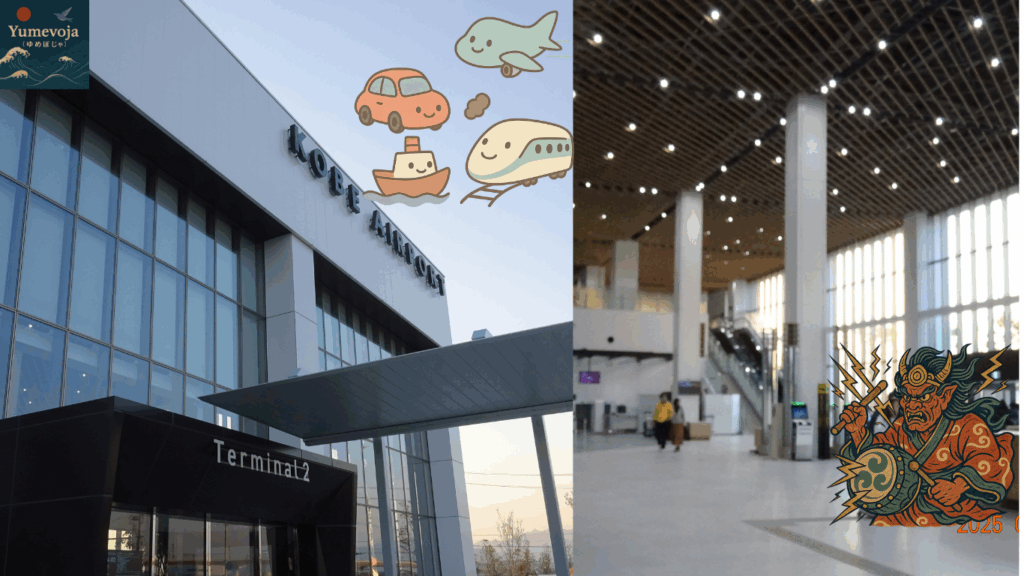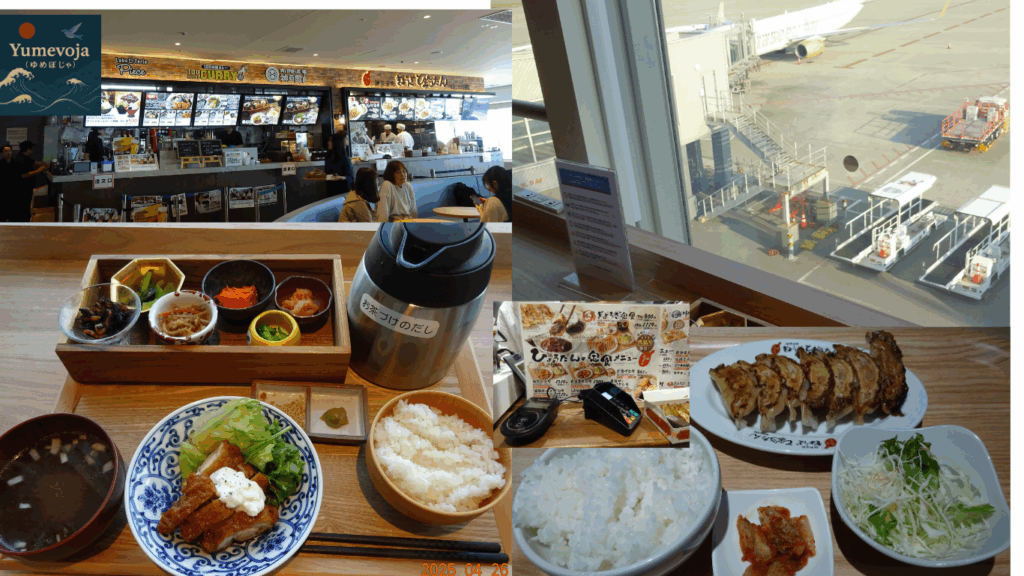Visited: April 26, 2025
Kobe Airport may be a “small player” compared to Kansai International or Itami Airport.
But it’s precisely that small size that makes it just right.
You can skip the crowds and quietly set off on your journey from a location close to the city center.
Seasoned travelers will appreciate this hidden-gem feeling.
Check-in is smooth, and from the observation deck, planes appear almost within reach.
Even the airport dining is not to be underestimated—
the octopus rice I tried was truly a “local treasure.”
Now, Kobe Airport has gained a new set of wings with the launch of international flights,
welcoming travelers from Korea, China, and Taiwan as a “small gateway” to Japan.
From here, your journey naturally extends to Kansai—Osaka, Kyoto, and Nara.
“Small in size, but unlimited in value.”
That’s exactly what this airport is.

When the God of Travel Descends into an Empty Space
The second terminal, where international flights arrive and depart, has only just begun operations.
To be honest, it still feels like the sparkle and bustle are yet to come.
But perhaps that’s exactly why you notice certain things.
In the quiet, the sky and sea stretch endlessly before you.
It feels like “the future is still a blank canvas,” a place with room to breathe.
Here, you can find a sense of travel’s promise—an encounter that exists only right now.
Three Airports in Kansai? Which One Should You Use?
Kansai is home to three airports.
Choosing the right one depends on your travel style.
| Airport | Key Features | Best For |
|---|---|---|
| Kansai International Airport (KIX) | Major international hub with numerous flights and large facilities | Ideal for international arrivals and departures |
| Itami Airport (ITM) | Closest to Osaka city, domestic flights only | Perfect for business trips or short domestic stays |
| Kobe Airport (UKB) | Small, quiet, and conveniently located | Travelers who value easy access and a relaxed atmosphere |
✈️ For example, you could arrive at Kobe Airport from overseas, enjoy a day trip to Osaka, Kyoto, or Nara, and then fly back home from Kansai or Narita International Airport—quick and seamless.
The Three Airports of Kansai and the History of International Flights.
🛫 Itami Airport: The Beginning of Kansai’s Sky
Once the main gateway to the skies of Kansai, Itami Airport connected Japan with the world, handling both domestic and international flights.
However, due to its close proximity to the city and the resulting noise issues, its role gradually changed over time.
In 1994, with the opening of Kansai International Airport, Itami was reborn as a domestic-only airport.
Today, it remains an essential hub for both business and leisure travel, offering convenient access to the heart of the Kansai region.
🌉 Kansai International Airport: A Maritime Gateway to the World
Opened in 1994, Kansai International Airport (KIX) was built on an artificial island in Osaka Bay to address the noise issues at Itami Airport.
Designed as a fully operational 24-hour international hub, it quickly became the beating heart of air travel between Kansai and the world.
Over the years, KIX has grown into a major gateway to Asia, driven by the expansion of low-cost carriers (LCCs) and the steady rise in inbound tourism.
Today, it stands as a symbol of connection—linking cultures, economies, and travelers across the globe.
🚢 Kobe Airport: A New Challenge Amid Tranquility
Opened in 2006, Kobe Airport (UKB) is a small, city-close airport accessible via the Port Liner from Sannomiya—just one subway stop from Shin-Kobe Station on the Shinkansen line.
For many years, it operated domestic flights only, but in 2023, it welcomed its first international charter flights. Then, in 2025, regular international services began, marking the start of a new chapter as the Kansai region’s third airport.
While the lively crowds are yet to come, its calm atmosphere, convenient access, and sweeping views of the sky and sea already give it a charm all its own.

Watching Airport Staff at Work, Right Before Your Eyes
At Kobe Airport’s observation deck and terminal,
you can watch airport staff at work right before your eyes.
From guiding passengers at the boarding gates, to ground handling as they load luggage,
to waving marshalling wands as they send off the aircraft—it’s like watching a live stage performance.
Scenes that can only be glimpsed from afar at major airports
unfold here at Kobe Airport within arm’s reach.
This closeness is a privilege unique to a small airport.

The newly opened food court in Terminal 1
The newly opened food court in Terminal 1 is spacious and filled with natural light.
Among its offerings, the standout is the local specialty tako-meshi—octopus rice made with fresh, regional ingredients.
The gentle aroma of dashi broth and the tender, springy texture of the octopus
create a flavor that brings the sea to life with every bite.
It’s the perfect choice both to kick off your journey and to wrap it up on a satisfying note.

If you take a seat by the window, the runway and aircraft are right before your eyes.
You can watch takeoffs and landings while enjoying your meal—
a slightly luxurious moment to savor.
It’s a sense of closeness you can’t experience at a major airport,
and one that is unique to Kobe Airport.
An Airport That Quietly Supports Your First Journey
At the airport food court, an elderly woman approached me.
“Today is my first time flying alone,” she said with a slightly nervous yet cheerful smile. “I’m taking a little solo trip to Kyushu.”
When I told her about my own solo pilgrimage journey, she was genuinely surprised. Somehow, we both felt, “Alone, but not really alone,” and shared a quiet boost of courage.
Kobe Airport may not be grand or bustling, but perhaps it’s a place that quietly supports someone’s firsts.
A Small Airport by the Sea That Gently Wraps Around Your Journey
Small airports have a charm that large ones can’t match. Kobe Airport is a place where you can escape the crowds and quietly feel the sky and sea. It’s there for you—whether at the start of your trip or at the end—offering gentle companionship.
And those small moments you encounter here will likely shine brightly in your travel memories for years to come.
Why not choose Kobe Airport as the gateway to your next adventure?

Today’s bonus capsule!
✨ Gateway to the Showa Era
The Showa era (1926–1989) was a time when modern appliances began to change everyday life in Japan.
In the 1950s, three items in particular became symbols of progress: the black-and-white television, the washing machine, and the refrigerator. People called them the “Three Sacred Treasures,” borrowing a phrase from ancient Japanese mythology.
Television played a special role. In 1959, the wedding parade of Crown Prince Akihito and Michiko Shoda was broadcast nationwide. It was a historic moment that encouraged many families to buy their first TV set, eager to watch the celebration at home.
Only a few years later, the 1964 Tokyo Olympics accelerated another change—the shift from black-and-white to color broadcasting. Seeing sports and international events in vivid color captured the imagination of an entire nation.
For me, television is tied to childhood memories. I clearly remember watching colorful anime, yet I was told that I had also seen some early black-and-white ones. Perhaps those images blended into my memory as if they had always been in color.
Looking back, these “treasures” remind us how technology reshaped not just daily routines, but also how people saw the world—sometimes literally, through a brighter screen.
